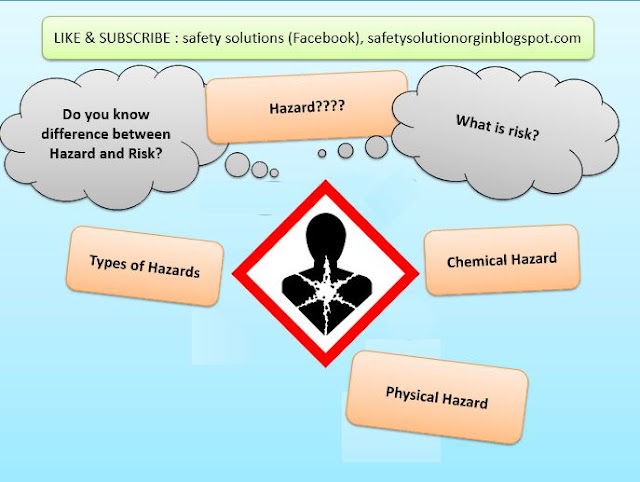Industrial Health and Safety blogs.
What is hazard? What is risk? What are the types of hazards?Do you know
the difference between Hazard and Risk?
Anything which has potential to
cause harm is known as hazard. Anything means anything. Examples are as below:
1-
Sharp
protruded nail is hazard.
2-
Hot
machine surface is hazard.
3-
Rotating
coupling part without machine guard is hazard.
4-
High
speed diesel vapors are chemical hazard.
5-
Open
wire, damage insulation, puncture wire are examples of electrical hazard.
6-
Fall
from height is work at height hazard.
7-
Broken
welding holder exposing conductor is also an electrical hazard.
8-
Slippery
portable ladder rung is also a hazard.
9-
Hanging
load is also a hazard.
10-
Potholes,
hole in floor are also examples of hazard.
Few below mentioned are hazards pictograms:
Types of Hazards:
Below are the common types of hazards you
should be aware of at work.
·
biological - bacteria, viruses,
insects, plants, birds, animals, and humans, etc.,
·
Electrical- High voltage, bare wire
etc.
·
Physical- include slips, trips, falls and exposure to
loud noises, working from heights, vibrations, and unguarded machinery.
·
chemical - depends on the physical,
chemical and toxic properties of the chemical,
·
ergonomic - repetitive movements,
improper set up of workstation, etc
Risk is combination of probability and consequence/ severity. Risk is
major or minor; less or more; high or low depends upon the combination of
probability and severity. Below examples provide more clarity of risk following
the risk classification matrix:
Example 1- Lifting of 25 kg load
-
Likelihood/
Probability of hazardous event according to above risk matrix is Unlikely (D)
-
Consequence
/ Severity of hazardous event is Minor (4)
-
Risk
measured combining both likelihood and Consequence is 21 i.e. Low
Example 1- Lifting of 250 kg load
-
Likelihood/
Probability of hazardous event according to above risk matrix is Unlikely (D)
-
Consequence
/ Severity of hazardous event is Major (2)
-
Risk
measured combining both likelihood and Consequence is 12 i.e. Medium.
It is apparent from the above examples although activities were same,
likelihood is also same .However when we face hazardous event consequence/
severity related to 25 KG which is minor but hazardous event consequence /
severity related to 250 KG which is major. Hence risks also got change from low
to High.
Examples of Major and Minor risks are:
1-
Slip
on muddy water, may be risk is low but slip while carrying hot water, may be
risk is high due to hot water.
2-
Fall
from stool, may be risk is low. But when fall from first or second floor of
building, risk is high.
So it is very clear that risk is combination of Likelihood and
consequence (Please consider likelihood or probability, both words are same.
Similarly Consequence and severity are same.)









I wish to show thanks to you just for bailing me out of this particular trouble. As a result of checking through the net and meeting techniques that were not productive, I thought my life was done
ReplyDeletenebosh course in chennai
Very informative information..! About -Occupational Health and Safety Software
ReplyDelete